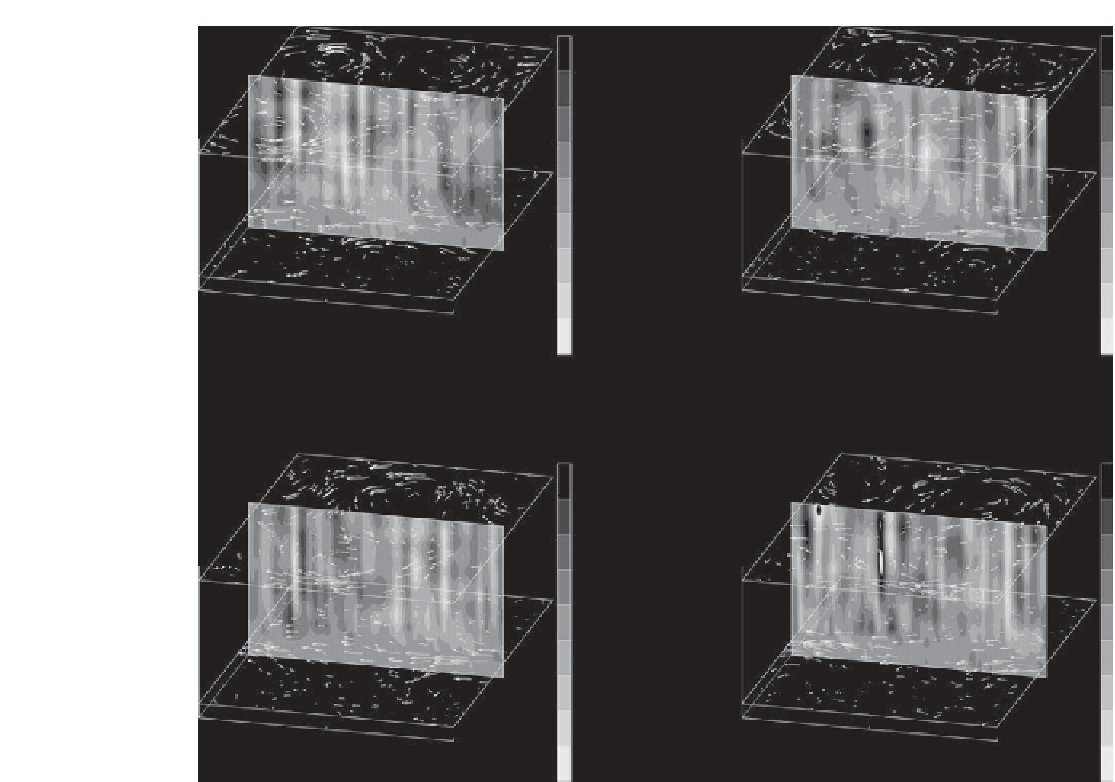Geoscience Reference
In-Depth Information
0.40
0.40
0.31
0.31
0.22
0.22
0.13
0.13
0.70
0.70
0.04
0.04
-0.04
-0.04
-0.13
-0.13
0.16
0.16
-0.22
-0.22
-2.16
0.00
-2.16
0.00
2.32
2.32
-0.31
-0.31
4.64
4.64
x
x
-0.40
-0.40
0.40
0.40
0.31
0.31
0.22
0.22
0.13
0.13
0.70
0.70
0.04
0.04
-0.04
-0.04
-0.13
-0.13
0.16
0.16
-0.22
-0.22
-2.16
-2.16
0.00
0.00
2.32
-0.31
2.32
-0.31
4.64
4.64
x
x
-0.40
-0.40
Figure 9.5.
A sequence of four time instances are shown in a 3D view illustrating the instantaneous, meridionally averaged vertical
motion field of the simulation described in the text. The colors with dark shading correspond to downward motions and lighter
shading corresponds to upward motions (mm/s). The anomalous (time-mean subtracted) horizontal wind field is plotted as vectors
illustrating the streamlines in two distinct vertical layers. The sequence is from top left to bottom right.
of fluxes of the primitive variables rather than to the
differentials of the variables themselves (as characteristic
of advective form schemes),
Smolarkiewicz and Margolin
[1997] concluded that the overall accuracy of the approx-
imation increases when the fluxes of the variables exhibit
a greater degree of homogeneity than the variables them-
selves. This may be the case in the QBO analogue simu-
lations with fairly steady wave momentum fluxes below
the critical layer. It is not clear if, in general, higher reso-
lution simulations are characterized by less homogeneity
of the prognostic variables compared to their associated
fluxes. However, this may be relevant since emerging new
dynamical core developments almost exclusively use flux
form formulations in contrast to most existing operational
NWP models today that employ the semi-Lagrangian
technique [
Williamson
, 2007].
It appears that with increased resolution, and lack-
ing suitable parametrizations, the role of higher-order
truncation errors of the numerical core itself gains impor-
tance, in particular also for the organization of convec-
tion, as implied by the ILES simulations by
Piotrowski
et al.
[2009] and the ones described above. For exam-
ple, in the case of the MJO-like solitary structures, when
the boundary meander is stopped after some time, the
solitary structures exhibit an extraordinary persistence
[
Wedi and Smolarkiewicz
, 2010]. Figure 9.6a shows the
result of a flux form Eulerian simulation that has been
restarted using the same flux form Eulerian scheme,
whereas Figure 9.6b shows the result of the simulation
restarted using a semi-Lagrangian scheme. Visibly the
persistence and the solitary anomaly in velocity poten-
tial is lost if the simulation is continued with the semi-
Lagrangian scheme. The results imply also a decisive
influence of the numerical model core on the formation
and the persistence of temporal flow anomalies, which
is consistent with the large discrepancies found in the















